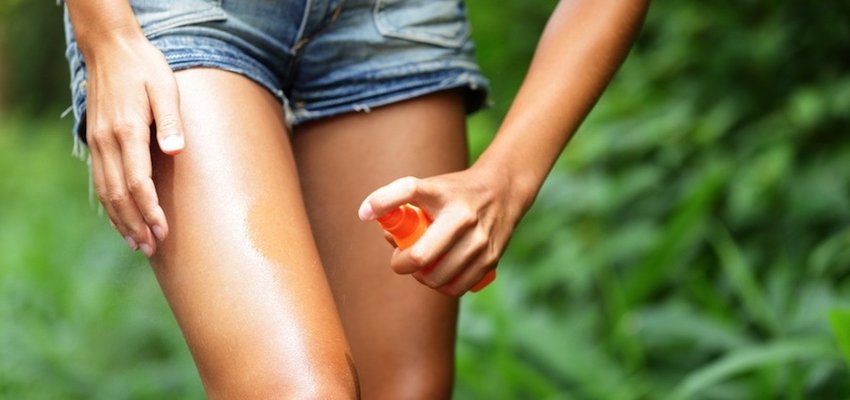
But! As usual, herbs are there to protect, defend, nourish and soothe the skin. Avoiding DEET, a common ingredient in most conventional bug sprays (or diethyl-meta-toluamide) is important; up to 15% of DEET can be absorbed into the bloodstream, according to some studies. Yikes, right? Even the FDA advises caution and using DEET sparingly.
Note: if you’re heading into a situation where malaria is a possibility, go with the DEET; its risks are a worthwhile compromise in light of the infectious disease.
On to the herbs:
1. Neem (Azadirachta indica):
Neem is a traditional Ayurvedic herb, popular in its native country of India. With its pesticide and germicide properties, it makes a very effective insect repellent. Mix ten (or so) drops of neem essential oil with a quarter cup coconut oil. Spread this on any exposed skin. Some African and Indian studies show that neem is effective against mosquitoes for up to 12 hours. Avoid neem oil if your skin is cut, broken, or abraded.
2. Eucalyptus oil (Eucalyptus globulus):
If you dislike the scent of citronella (which, admittedly, I do), eucalyptus is a good substitute. You can use the essential oil in an aromatherapy burner to keep mosquitoes away from your backyard festivities, or mix five or six drops with one quarter cup coconut oil and use topically. Note: eucalyptus essential oil, even in a carrier oil, can sting sensitive skin, so test a small patch before you apply it to the rest of your body.
Note: never take eucalyptus oil internally.
3. Catnip (Nepeta cataria):
Catnip is strong protection against biting insects and easily made a part of your daily herb protocol. The human body gives off a myriad of scents seemingly designed to attract mosquitoes and their ilk, but the scent your body exudes after ingesting catnip can discourage insects from finding you so irresistible.
To make catnip tea, brew (at least) two teaspoons per cup of hot (not quite boiling) water and steep for ten minutes. You can also take a couple of catnip capsules a few hours before venturing outside. Catnip is absolutely safe for children and breastfeeding women, but should be avoided while pregnant.
4. Basil (Ocimum basilicum), Fennel (Foeniculum vulgare), Lavender (Lavandula spp), and Peppermint (Mentha piperita):
Fennel, lavender and peppermint are all strong repellents (lavender is especially good if ticks are a worry), but only last 60-90 minutes on their own. When combined with basil oil, however, you’re looking at about eight hours of protection (though I’d reapply well before then).
You don’t have to use all of these oils, unless you like the resulting scent. For my skin, peppermint is too strong, so I opt for five drops basil essential oil, and then two drops of any (or all) of the other oils mixed with a quarter cup coconut oil.
Note: peppermint essential oil is an insect and pest repellent in the home. Sprinkle the oil on cotton balls and stuff them in doorways and windowsills to discourage mice, spiders, mosquitoes, and even squirrels (if, for example, they tend to eat through your screens and steal sweet potatoes from your kitchen; I may be speaking from experience here). Refresh every few days.
Bonus:
For pets:
If you’re looking for herbal flea solutions, you can try the following flea spray: mix equal parts apple cider vinegar (or white vinegar) with water. Add seven drops lavender essential oil, five drops rosemary (Rosmarinus officinalis) essential oil, and three drops eucalyptus essential oil per cup of liquid. Shake well and spray and massage into your pet’s coat. Again—make sure you test a small area first to make sure there’s no irritation.
Alternatively, you can make a flea powder (also good for applying to carpets in a flea infested house) by mixing equal parts cornstarch and baking soda with two tablespoons powdered lavender (or seven drops essential oil) and one tablespoon powdered rosemary (or five drops essential oil) per cup of powder.
Bite and Sting Relief:
If you’re out and about and get a bite or sting, plantain (Plantago major) will immediately relieve the pain and itching. Plantain grows everywhere; in fact, I’ll bet it’s growing in your yard right now, just waiting for you to go pick it (after you Google image it, of course, so you know you’re harvesting the right plant).
Dust off your plantain leaf (being sure that no pesticides or chemical fertilizers have been applied), chew it up and place on the sting. I know, I know … chew? Well, the enzymes in your saliva help to break down the plant membranes, releasing the pain-relieving, inflammation-reducing constituents.
Not really keen on harvesting your own? No worries. You can find plantain oil or dried plantain leaf in the herbal marketplace. Apply the oil to the bite or mix the dried leaves with a bit of warm water to form a poultice.
Don’t have plantain on hand? Well, if you’re a MBG regular, you probably have some apple cider vinegar (ACV) on hand. Apply this straight (or watered down) to a cotton ball and hold on the bite or sting until the discomfort stops. Refresh and reapply as often as needed.
Be well, herb it up, and enjoy summer — bite and sting free.
No comments:
Post a Comment